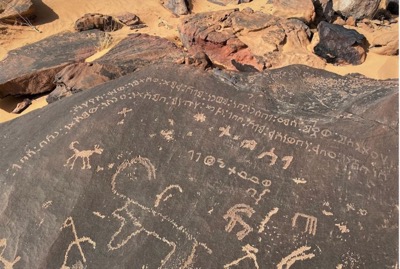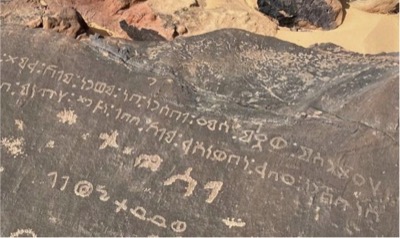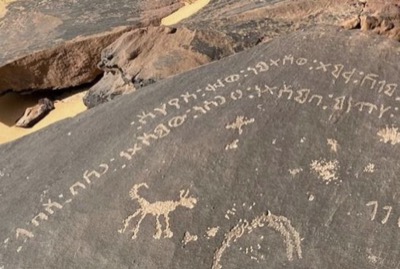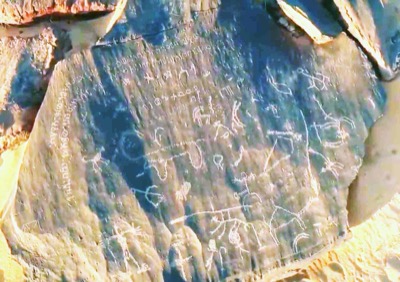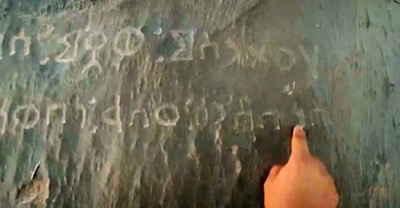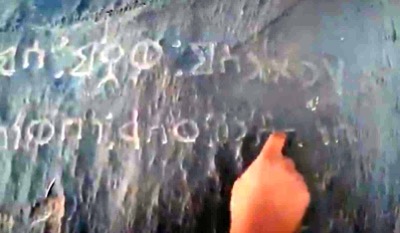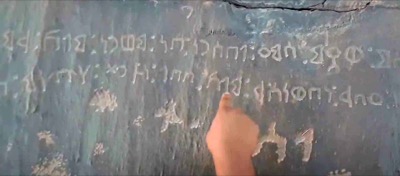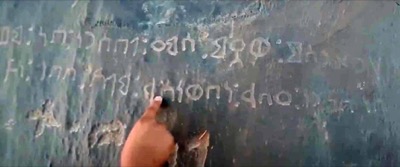Siglum: Internet.Dum 2 Script: Dumaitic
Transliteration
h ʿtrs¹m / w ṣlm / s¹mʿ / l- bs¹rn/ bn / mṭrn / mlk / dmt / w ʾtmn / wdd / ʾyhʾ
ʾn / bs¹rn / ʿbd / nbwnʾd / mlk / bbl / nẓrt / h- ġnm / b- mʾtn / frs¹n / w mʾtn / rkb / ʾbl
Translation
O ʿtrs¹m and Ṣlm pay heed to Bs¹rn son of Mṭrn king of Dmt and fulfill the wish of ʾyhʾ
I am Bs¹rn servant of Nbwnʾd king of Babylon I have guarded the booty with two hundred horsemen and two hundred camel-riders
Apparatus Criticus
Al-Ḥāǧǧ 2019 considered the two lines to be separate inscriptions and both to be "Thamudic".
He reads bḍrn for bṭrn in line 1 and nṭrt for nẓrt in line 2.
Commentary
The inscription was put on Twitter in a video by Professor ʿAqlā bin Turkī Al-Rabīʿah see https://twitter.com/aqlaalrbeah/status/1293867413197520896 which was consulted on 12th August 2020. It had already been published by Al-Ḥāǧǧ (2019).
The text is almost certainly related to Internet.Dum 1 which is by someone with the same name, though it is interesting that there he spells the goddess's name ʿtrs¹my and uses a different form of ṣ in ṣlm. See the commentary on that text. The author here originally omitted the l in ṣlm but added it above the line.
Note the prayer to Ṣlm by a man from Dūmah in the Safaitic inscription KRS 30.
Although most of the letter-forms are similar to those of Taymanitic, there are four unusual letter shapes in this text. One is the Ancient South Arabian ṭ in the name mṭrn, rather than the normal Taymanitic form of a saltire within a square. The second is what is read here as ẓ in nẓr which has a form similar to the ẓ in Hismaic, a "T" shape but turned 90º counter-clockwise and with what would then be the vertical line lengthened and the horizontal shortened. The third is the ġ in ġnm which is like an Ancient South Arabian ġ but with a short diagonal on either side, though it is not entirely certain that the right diagonal is part of the letter and not an extraneous stroke. Finally, the f in frs¹n towards the end of line 2 is made up of two arcs facing each other and interestingly is found in a hlḥm (i.e. an alphabet set out in the South Semitic letter order) found in Jordan in a script in which most of the other shapes are those of Thamudic B (See Al-Jallad & Al-Manaser 2015).
Here the spelling of the king of Babylon's name as nbwnʾd is quite different from its form in the Taymanitic and Thamudic B inscriptions mentioning him where it is written nbnd. The spelling here reflects almost exactly that in Akkadian dNabû-naʾid including the mater lectionis w for the û.
This is the first reference by name to a king of Dūmah, an oasis which curiously is not mentioned in what survives of Nabonidus' accounts of his conquest of north-west Arabia, though, in the form Adumatu, it occurs frequently in the Annals of the Neo-Assyrian Kings Sennacherib, Esarhaddon, and Assurbanipal (sse Ephʿal 1982: 118 ff).
It is not clear who or what is ʾyhʾ at the end of line 1.
Subjects
Prayer
Deity
Genealogy
Place-name
Outside peoples
Domestic animals
Military
Country: Saudi Arabia
Region: Tabuk Province
Site: Maḥaǧǧah
Present Location: In situ
Find date: 2020
Field collector: Professor ʿAqlā bin Turkī Al-Rabīʿah
Notes: According to Al-Ḥājj 2019: 80, the inscription was found at an outcrop called Maḥaǧǧah, some 30 km south-west of Taymāʾ.
Associated Signs: feet and geometric figures
Associated Drawings: Many drawings from different periods: Naked aroused male figures, stick-figure horsemen, camels, ibex (?)
Associated Inscriptions: Internet.ThamB 3
References:
Al-Ḥāǧǧ, M.A. Ḥamlat al-malik al-bābilī nabūnayd ʿalā taymāʾ min ḫilāl naqšayn ṯamūḍiyayn ǧadīdayn malik dūmah (Adūmātū). Maǧallat Hayrūdūt 10, 2019: 11–96.
Al-Jallad, A.M. & Al-Manāsīr [Al-Manaser], A.Y.Kh. A Thamudic B abecedary in the South Semitic letter order. Pages 1-15 in A.M. Butts (ed.), Semitic Languages in Contact. (Studies in Semitic Languages and Linguistics, 82). 2015.
Ephʿal, I. The Ancient Arabs. Nomads on the Borders of the Fertile Crescent 9th-5th Centuries B.C.. Jerusalem: Magnes / Leiden: Brill, 1982.
URL of this record (for citation): http://krc.orient.ox.ac.uk/ociana/corpus/pages/OCIANA_0057010.html
